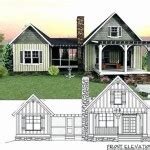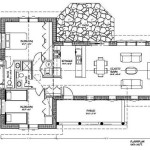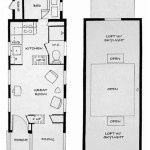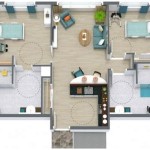A family house plan refers to a set of architectural drawings and specifications that outline the design and layout of a residential dwelling intended to accommodate a family’s needs. These plans provide a comprehensive framework for the construction of a family home, ensuring that it meets functional requirements, aesthetic preferences, and building codes.
To illustrate, when designing a family house plan, architects consider factors such as the number of bedrooms and bathrooms needed, the size and layout of living areas, the inclusion of amenities like a playroom or home office, and the accessibility features required for family members with specific needs. The plan serves as a blueprint for the overall structure, including its exterior and interior design, electrical and plumbing systems, and energy efficiency measures.
With these introductory insights, let’s delve into the main aspects of family house plans, exploring the key elements they encompass, the factors to consider when designing them, and the benefits they offer in creating comfortable and functional living spaces for families.
When designing a family house plan, consider these 9 important points:
- Number of bedrooms and bathrooms
- Size and layout of living areas
- Inclusion of amenities (playroom, home office)
- Accessibility features for family needs
- Exterior and interior design
- Electrical and plumbing systems
- Energy efficiency measures
- Building codes and regulations
- Budget and financial considerations
Taking these factors into account helps create a family house plan that meets your specific needs and aspirations.
Number of bedrooms and bathrooms
When determining the number of bedrooms and bathrooms in a family house plan, several key factors need to be considered. These include the size and composition of the family, their current and future needs, and the available space and budget.
Family size and composition: The number of bedrooms should generally correspond to the number of family members, with each person ideally having their own private space. However, factors such as age, gender, and personal preferences may influence the allocation of bedrooms.
Current and future needs: It’s important to consider not only the immediate needs of the family but also their potential future needs. For example, if there are plans for children or elderly relatives to move in, additional bedrooms may be necessary. Similarly, if family members have specific accessibility requirements, these should be taken into account when planning the layout and number of bedrooms.
Available space and budget: The size of the building lot and the overall budget for the house will ultimately determine the number of bedrooms and bathrooms that can be accommodated. It’s essential to strike a balance between desired amenities and financial constraints.
Additional considerations:
- Guest room: If the family frequently hosts guests, a dedicated guest room may be a valuable addition.
- Ensuite bathrooms: Ensuite bathrooms, directly accessible from a bedroom, provide added privacy and convenience, especially for larger families or those with limited mobility.
- Jack-and-jill bathrooms: Jack-and-jill bathrooms, shared between two bedrooms, can be a space-saving solution for smaller homes.
- Powder room: A half-bathroom, also known as a powder room, located on the main level of the house can be a convenient feature for guests and family members.
Size and layout of living areas
The size and layout of living areas in a family house plan are crucial factors to consider as they impact the overall functionality, comfort, and lifestyle of the family.
Size of living areas: The size of living areas should be proportionate to the size of the family and their daily routines. For example, a family with young children may require a larger family room to accommodate toys, play areas, and activities. Similarly, a family that frequently hosts guests may need a more spacious living room and dining room to entertain comfortably.
Layout of living areas: The layout of living areas should promote seamless flow and connectivity between different spaces. An open floor plan, with minimal walls or barriers, can create a sense of spaciousness and allow for easier supervision of children. However, it’s essential to define separate areas for different activities, such as a cozy corner for reading or a dedicated workspace.
Relationship between living areas: The relationship between living areas should facilitate family interaction and togetherness. For instance, the kitchen, dining area, and family room can be arranged in close proximity to create a central gathering space. Additionally, consider the placement of windows and natural light sources to enhance the ambiance and create a welcoming atmosphere.
Flexibility and adaptability: Living areas should be designed with flexibility and adaptability in mind to accommodate changing family needs over time. For example, a playroom can be designed to convert into a guest room or home office as children grow older. Similarly, modular furniture and movable partitions can allow for easy reconfiguration of spaces to suit different occasions and activities.
Inclusion of amenities (playroom, home office)
Playroom
A playroom is a dedicated space designed for children to engage in play activities, foster creativity, and socialize. In a family house plan, a playroom offers numerous benefits:
- Provides a safe and stimulating environment: A playroom can be designed with safety features such as soft flooring, rounded edges, and age-appropriate toys. It allows children to play and explore freely without the potential hazards of other areas of the house.
- Encourages creativity and imagination: A well-equipped playroom can stimulate children’s imagination and creativity. It can include a variety of toys, art supplies, building blocks, and imaginative play props, encouraging imaginative play and cognitive development.
- Promotes socialization and interaction: A playroom can serve as a central gathering space for children and their friends. It encourages social interaction, cooperation, and the development of communication skills.
- Reduces clutter in other areas of the house: By providing a dedicated space for toys and play activities, a playroom helps keep other areas of the house tidy and organized.
Home office
A home office is a designated workspace within the family home, designed to accommodate work-from-home arrangements, professional activities, or hobbies that require a dedicated and private space.
- Supports work-life balance: A home office allows family members to work from home without the distractions and interruptions of a traditional office environment. It provides a dedicated space where they can focus and maintain a healthy work-life balance.
- Provides flexibility and convenience: A home office offers flexibility in terms of work hours and schedules, allowing family members to accommodate their personal and professional responsibilities more easily.
- Enhances productivity: A well-designed home office can boost productivity by providing an ergonomic and organized workspace that minimizes distractions and promotes efficiency.
- Facilitates hobbies and personal projects: A home office can also serve as a space for pursuing hobbies, personal projects, or creative endeavors that require a dedicated and quiet environment.
When incorporating amenities like a playroom or home office into a family house plan, careful consideration should be given to their size, location, and accessibility. These spaces should be designed to seamlessly integrate with the overall flow of the house while providing the necessary functionality and privacy.
Accessibility features for family needs
Universal design principles
Universal design principles aim to create environments that are accessible and usable by people of all ages, abilities, and disabilities. Incorporating these principles into a family house plan ensures that the home is inclusive and accommodates the diverse needs of family members.
Some key universal design principles include:
- Equitable use: The design should be usable by people with diverse abilities, regardless of their age, disability, or physical characteristics.
- Flexibility in use: The design should accommodate a wide range of individual preferences and abilities.
- Simple and intuitive use: The design should be easy to understand and operate, minimizing the need for adaptation or specialized knowledge.
- Perceptible information: The design should provide information that is easily perceptible, regardless of sensory abilities.
- Tolerance for error: The design should minimize the risk of unintentional or accidental errors.
Specific accessibility features
In addition to universal design principles, specific accessibility features can be incorporated into a family house plan to address the needs of family members with disabilities or age-related impairments.
These features may include:
- Ramps and elevators: Ramps and elevators provide accessible pathways for individuals with mobility impairments to navigate different levels of the house.
- Wider doorways and hallways: Wider doorways and hallways allow for easier movement of wheelchairs and mobility aids.
- Grab bars and handrails: Grab bars and handrails in bathrooms, showers, and hallways provide additional support and stability for individuals with balance or mobility issues.
- Accessible kitchen and appliances: Accessible kitchens feature adjustable counter heights, roll-under sinks, and easy-to-reach appliances, making meal preparation and cleanup more accessible for individuals with disabilities.
- Assistive technology: Assistive technology, such as voice-activated controls, smart home devices, and communication aids, can enhance independence and accessibility for individuals with cognitive or sensory impairments.
By incorporating accessibility features into a family house plan, families can create a home environment that is safe, comfortable, and inclusive for all family members, regardless of their abilities or age.
Exterior and interior design
Exterior design
The exterior design of a family house plan should reflect the family’s lifestyle and aesthetic preferences while considering factors such as curb appeal, functionality, and energy efficiency.
Curb appeal: The exterior design should create a visually appealing and welcoming first impression. This can be achieved through a combination of architectural features, landscaping, and color choices. Consider the architectural style of the neighborhood and choose materials and finishes that complement the surrounding environment.
Functionality: The exterior design should also prioritize functionality. Consider the need for outdoor living spaces, such as a patio or deck, and ensure that there is adequate space for activities like gardening or recreation.
Energy efficiency: Energy-efficient exterior features can reduce energy consumption and lower utility bills. Consider factors such as insulation, window glazing, and the use of sustainable materials.
Interior design
The interior design of a family house plan should create a comfortable, functional, and aesthetically pleasing living environment for all family members.
Layout: The layout of the house should promote seamless flow between different spaces and accommodate the family’s lifestyle. Consider the placement of rooms, the size and shape of spaces, and the connections between indoor and outdoor areas.
Functionality: The interior design should prioritize functionality and meet the family’s specific needs. Consider factors such as storage space, traffic flow, and the need for dedicated spaces for activities like cooking, dining, entertaining, and work.
Style and aesthetics: The interior design should reflect the family’s personal style and preferences. Choose a color palette, furniture, and dcor that create a warm and inviting ambiance.
By carefully considering both exterior and interior design, families can create a home that not only meets their functional needs but also reflects their unique character and lifestyle.
Electrical and plumbing systems
Electrical systems
Electrical systems in a family house plan are responsible for providing safe and reliable power distribution throughout the home. Key considerations include:
- Lighting: Plan for a combination of natural and artificial lighting to create a well-illuminated and inviting living environment. Consider the placement of windows, skylights, and light fixtures to maximize natural light and minimize energy consumption.
- Power outlets and switches: Ensure there are sufficient power outlets and switches conveniently located throughout the house to accommodate the family’s electronic devices, appliances, and lighting fixtures. Consider the placement of outlets near furniture, workspaces, and high-traffic areas.
- Electrical panel: The electrical panel is the central distribution point for electricity in the house. It should be easily accessible and have sufficient capacity to handle the electrical load of the home.
- Safety features: Incorporate safety features such as ground fault circuit interrupters (GFCIs) and arc fault circuit interrupters (AFCIs) to protect against electrical hazards.
Plumbing systems
Plumbing systems in a family house plan ensure the provision of clean water and the removal of wastewater. Key considerations include:
- Water supply: Plan for an adequate water supply to meet the daily needs of the family, including drinking, cooking, bathing, and laundry. Consider the location of water sources and the installation of water filtration systems if necessary.
- Drainage: The drainage system should efficiently remove wastewater from the house and prevent clogs and backups. Consider the placement of drains, pipes, and vents to ensure proper drainage.
- Fixtures and appliances: Select water-efficient fixtures and appliances to conserve water and reduce utility bills. Consider low-flow toilets, faucets, and Energy Star-rated appliances.
- Water heater: The water heater provides hot water for the house. Choose a water heater with sufficient capacity and energy efficiency to meet the family’s needs.
By carefully planning and installing electrical and plumbing systems, families can ensure a safe, comfortable, and functional living environment in their new home.
Energy efficiency measures
Incorporating energy efficiency measures into a family house plan can significantly reduce energy consumption, lower utility bills, and create a more sustainable living environment. Key energy efficiency measures to consider include:
- Insulation: Proper insulation in walls, ceilings, and floors helps maintain a comfortable indoor temperature, reducing the need for heating and cooling systems. Consider using high-performance insulation materials with a high R-value.
- Windows and doors: Energy-efficient windows and doors with double or triple glazing and low-emissivity (Low-E) coatings help reduce heat transfer and improve insulation. Look for windows and doors with a high Energy Star rating.
- Appliances: Choose Energy Star-rated appliances, such as refrigerators, dishwashers, and washing machines, which meet strict energy efficiency standards. These appliances consume less energy while maintaining performance.
- Lighting: LED and CFL bulbs are energy-efficient lighting options that consume less energy compared to incandescent bulbs. Consider installing dimmers to adjust lighting levels and further reduce energy usage.
Implementing these energy efficiency measures in a family house plan not only saves energy and costs but also contributes to a more sustainable and environmentally conscious home.
Building codes and regulations
Building codes and regulations are established by local and national authorities to ensure the safety, structural integrity, energy efficiency, and accessibility of buildings. These codes and regulations provide a framework for the design and construction of family house plans, ensuring that they meet minimum standards and provide a safe and habitable living environment.
Building codes typically cover a wide range of aspects related to the construction of a house, including:
- Structural requirements: These codes specify the minimum structural requirements for a house, ensuring that it can withstand various loads and forces, such as wind, snow, and earthquakes.
- Fire safety: Building codes include fire safety regulations to minimize the risk of fire and protect occupants in the event of a fire. These regulations cover aspects such as fire-resistant materials, smoke detectors, and emergency escape routes.
- Energy efficiency: Energy efficiency codes set standards for the energy performance of a house. These codes aim to reduce energy consumption and promote the use of energy-efficient appliances, insulation, and building materials.
- Accessibility: Building codes include accessibility requirements to ensure that buildings are accessible to individuals with disabilities. These requirements cover aspects such as wheelchair ramps, accessible bathrooms, and wider doorways.
It’s important to note that building codes and regulations can vary depending on the jurisdiction. When designing a family house plan, it’s essential to consult with local building authorities to ensure that the plan complies with all applicable codes and regulations. This helps ensure a safe, compliant, and habitable living space for the family.
Budget and financial considerations
Budget and financial considerations play a crucial role in the design and construction of a family house plan. Families need to carefully plan their budget, taking into account the various costs associated with building and maintaining a home. These costs can be broadly categorized into the following:
1. Land acquisition:
The cost of land is a significant expense, especially in urban areas. Factors such as location, size, and topography influence the land price. Families should research and compare land prices in different areas to find a suitable lot that fits their budget and needs.
2. Construction costs:
Construction costs include the materials, labor, and equipment required to build the house. The size, complexity, and materials used significantly impact the construction costs. Families should obtain quotes from multiple contractors and compare their estimates to determine a realistic budget for construction.
3. Permits and inspections:
Building permits and inspections are necessary to ensure that the house complies with local building codes and regulations. The cost of permits and inspections varies depending on the jurisdiction and the size of the project. Families should factor these costs into their budget to avoid unexpected expenses.
4. Utilities and infrastructure:
Connecting the house to utilities such as electricity, gas, water, and sewage can involve additional costs. The cost of installing these utilities depends on the location and availability of services. Families should inquire with local utility providers to estimate these costs.










Related Posts








